
29 Sep Back from the Brink
“The buffalo furnished them meat, robes for bedding, skins for teepee coverings, clothing, foot gear, sinew for sewing, bone splinters for sewing awls, and many other items they required.”
— Dominic Michell, Salish Tribal Elder, Circa 1942
While precise numbers are impossible to determine, most authorities estimate a North American buffalo population between 30 and 80 million prior to the arrival of Europeans. This was likely the largest concentration of ungulates the world has ever seen, and their grazing and movement patterns shaped the entire ecology of the Great Plains. Astoundingly, by the early 1900s, the animals had nearly been extirpated, largely due to commercial hunting. Vintage photographs show mountains of buffalo hides piled up at railheads, awaiting transport to Eastern markets. No one felt the impact of this biological disaster more than the Plains Indian Tribes, who had relied on the buffalo as a source of food, clothing, and shelter for thousands of years.
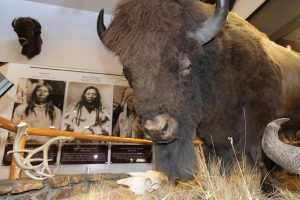
Commercial hunting’s impact on the once thriving buffalo population was absolute and devastating by the early 1900s, reducing numbers to near extinction.
While the Coastal Salish people now enjoy an established presence in the Northwest, they originally lived east of the Continental Divide. Gradually, Plains Tribes like the Blackfeet pushed them west of the mountains into territory occupied by tribes with whom they shared a common language family, such as the Upper Pend d’Oreille. As a part of the Hellgate Treaty of 1855, which established the Flathead Indian Reservation, these related groups merged with the Kootenai, who spoke a different language, forming the Confederated Salish and Kootenai Tribes (CSKT). To no surprise, however, non-Native interests and the federal government violated the terms of the Hellgate Treaty repeatedly.
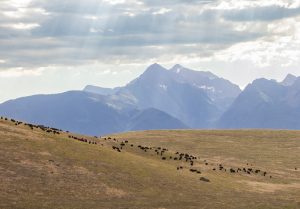
The herd occupying the Bison Range is finally thriving under the Tribes’ successful, and rightful, management and stewardship.
The arrival of white settlers hastened westward migration for the Salish. While fish became increasingly important as a source of nutrition in their new home, the Salish people still made regular forays to the plains — which often ended in battles with the Blackfeet. Since the Blackfeet obtained firearms before the Salish, these conflicts further contributed to Salish displacement.
Because much of what follows is recorded through oral history, precise dates can’t always be determined, but by the 1870s, the decline in the buffalo population on the Flathead Reservation was obvious to Tribal elders. A Pend d’Oreille named Altatice, or Prairie Falcon Robe, herded a small group of young buffalo home with him from a hunt, which led to a debate among elders about what to do with them. Some argued for keeping the animals to repopulate the reservation, but they were ultimately overruled. To his chagrin, Altatice had to send the animals back to the wild.
After another hunting trip to the east, Altatice’s son Latati, or Little Prairie Falcon Robe, had six orphaned calves follow him all the way home across the Continental Divide, which was not unusual behavior for immature buffalo. He intended to keep them as brood stock, but by this time his mother had remarried Samuel Walking Coyote, who appropriated the calves and sold them to Michel Pablo and Charles Allard in 1884, to Latati’s dismay. History erroneously recognizes Walking Coyote, who sold the herd without permission, with the return of buffalo to Tribal lands, but Latati deserves the credit. As Salish Tribal member Lassaw Redhorn recounts in I Will Be Meat for My Salish: The Montana Writers Project and the Buffalo of the Flathead Indian Reservation, “I knew Indian Samuel very well. … I’ve seen the calves he brought to [Flathead Valley]. Whether he captured them himself or some other Indian gave them to him, that I do not know, as he did not tell me how he got them.”
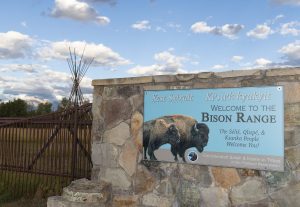
In 1908, Congress authorized the creation of the National Bison Range, which occupies over 18,000 acres near the Mission Mountains.
Pablo and Allard cared about the young herd, which thrived under their supervision and eventually became the largest on the continent. Its progeny restored buffalo to multiple locations, including Yellowstone National Park. Genetics from that herd survive in almost all American buffalo living today.
When Allard died, his estate sold his share of the herd to a Kalispell rancher. Then, when Pablo tried to transfer his portion of the buffalo to the federal government, the U.S. refused the offer. The Canadian government, however, welcomed the animals and Pablo sent most of the buffalo to Alberta in 1907.
The Indigenous riders who herded the buffalo to the railhead in Ravalli, Montana for shipment north remembered the drive as one of the greatest rodeos of all time. Men and women were hired for the job. As described by Mrs. Mary Blood, a Kootenai Tribal member whose brother Billy supervised the great drive:
Michel Pablo was very happy when Emily Ervine … offered her services as a rider on his buffalo roundup. He knew her ability as a top hand, as she had ably assisted at many a roundup of cattle. She had ridden broncs — bad ones at that — over every mile of the Flathead rangeland. Then too, she knew buffalo and how to handle them.
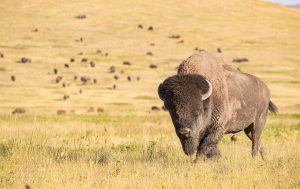
Powerfully built with thick hides and heavy bone, buffalo must have been a formidable quarry for Indigenous hunters armed with bows, arrows, and spears.
As interest in saving the buffalo from extinction began to expand beyond the Tribes, the American Bison Society formed in 1905 with the support of President Theodore Roosevelt. In 1908, Congress authorized the creation of the National Bison Range. University of Montana professor of wildlife Morton Elrod recommended the Flathead Reservation as a location for the new bison range, which took place without Tribal consultation despite Elrod’s good relationship with the Indigenous community.
The range occupied over 18,000 acres of formerly Tribal land adjacent to the Mission Mountains and tributaries of the Flathead River. The new National Bison Range soon aroused Tribal opposition when its manager surrounded it with fences without Tribal consent, ending access to the land. As a result, the Salish name for the range translates as “fenced in place.” Conflict increased when the Indian Allotment Act of 1908 opened much of the reservation to white homesteaders. Relations deteriorated even further when a 1936 decree barred Tribal members from working on the range.
The National Bison Range was initially stocked with 36 bison from remnants of the Pablo herd, supplemented by an animal from the Goodnight herd in Texas. A white buffalo, eventually named Big Medicine, was born on the range in 1933, where he lived until his death in 1959. White buffalo have always held great spiritual significance for Plains Tribes and throughout his life, Big Medicine remained a focus of pride and reverence for the people of the Flathead Reservation.
As a National Wildlife Refuge, the National Bison Range was managed by the U.S. Fish & Wildlife Service (FWS). Throughout this long history, the CSKT sought greater control of their land, including the bison range, as promised by numerous violated treaties. The 1975 Indian Self-Determination and Educational Assistance Act authorized such action — in theory. In 1994, the Tribes formally requested management authority over the bison range despite local opposition from non-Native interests. Confident in the Tribes’ ability to manage the property, numerous conservation organizations, including the National Wildlife Federation, Wilderness Society, and Montana League of Conservation Voters, supported the proposition.
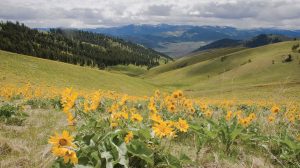
The entire ecosystem in the Bison Range has benefitted from the regenerative impact of a healthy herd.
In 2004, the Tribes finally negotiated an agreement authorizing the transfer, only to have it revoked by FWS for specious reasons, a move challenged by the Tribes. A second such agreement was signed in 2008, but two years later a federal court declared it invalid on procedural grounds. A third agreement in 2012 foundered when FWS failed to complete a necessary environmental analysis.
Then, in 2016, FWS agreed, in principle, to restore the National Bison Range to Tribal management, provided that CSKT maintained conservation standards and the range remained open to the public, although terms of this second stipulation were not defined. Finally, in 2021, the Bison Range Restoration Act formalized the transfer of the National Bison Range — now simply the Bison Range — to Tribal ownership and management as authorized by the Consolidated Appropriations Act. During the ongoing transition period, the CSKT is managing the Bison Range according to the terms of the 2019 FWS Comprehensive Conservation Plan.
Tribal Chairwoman Shelley Fyant says of the occasion, “The restoration of this land is a great historic event and we worked hard to reach this point. It comes after a century of being separated from the buffalo and the Bison Range, and after a quarter-century-long effort to co-manage the refuge with the FWS.”
Management of the land finally settled, but the issue of contested water rights remained. The 1855 Hellgate Treaty reserved water rights for the Tribes in exchange for millions of acres of land. However, these rights were never formalized and without a current water contract the CSKT, local landowners, and the federal government faced extensive, costly litigation while important Tribal projects ranging from irrigation to wildlife-habitat preservation remained delayed.
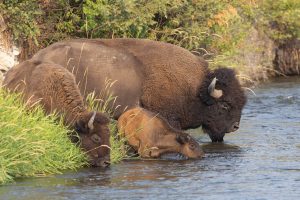
The range is occupied by a healthy, growing herd of 350 bison, more than the entire continental population in 1900.
The Tribes chose to negotiate, a decision that eventually resulted in the 2020 CSKT Water Compact, a complex compromise that included a payment of $1.9 billion as compensation for rights promised in the Hellgate Treaty. The agreement ensures existing rights for a variety of stakeholders, including local non-Tribal agricultural interests and Montana Fish, Wildlife & Parks. Approximately half of the money was earmarked for irrigation and wetlands-restoration projects, which benefited more non-Tribal agricultural interests than enrolled members of the CSKT.
While this protracted history of environmental loss and broken promises may seem discouraging, one can argue that all’s well that ends well, as Shakespeare put it. In addition to becoming a conservation success story, the Bison Range is finally being managed by its rightful owners. A healthy herd of some 350 bison now occupies the range — a number greater than the entire continental population in 1900 — an accomplishment that wouldn’t have been possible without determined effort by the CSKT.
This complex history leads us to the Bison Range as it is today — a little-known ecological gem 50 miles north of Missoula. While opportunities to view bison in their natural habitat would be worth a visit alone, the range is also home to a diverse population of species, including most other large mammals native to the region. Current management prioritizes the health of the buffalo herd, but the Tribes are also working to increase populations of bighorn sheep and pronghorn, eliminate invasive plant species, and address elk overpopulation — a concern in many parts of Montana.
For the current population of buffalo, healthy genetics remains a key priority. Dating back to the remnant Yellowstone National Park bison herd, the deliberate crossbreeding between cattle and wild bison introduced cattle genetics into wild herds — a problem that persists in some populations today. Bison Range managers are using modern laboratory methods to analyze buffalo DNA, and the range’s herd now appears free of cattle DNA.
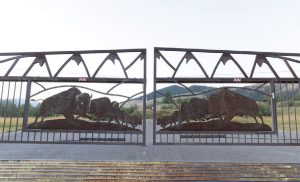
The Bison Range has long flown under the radar as a favorite location among wildlife photographers — Yellowstone without the crowds. Managers are attempting to reduce the range’s carbon footprint, and guided tours by electric vehicles are a future goal. Payable at the entrance gates, a nominal daily entrance fee of $10 has proved inadequate to cover operating expenses, but the Tribes are working to improve the balance sheet through low-impact tourism. The range is open year-round during daylight hours, although adverse weather may lead to closures.
A few notes seem appropriate at the end of this piece. Biologically, the American “buffalo” is not a buffalo, but a bison, distinct from true Old-World buffalo. The term “buffalo” is in such common use throughout the West and within the Native community that I have stuck with it despite its technical inaccuracy. A great deal of Salish oral history might have been lost save for the Depression-era Montana Writers Project, which, among other accomplishments, gathered stories from Salish elders in the collection I Will Be Meat for My Salish, the source of most quotations in this article. I would also like to thank Jeff Clairmont and Tom MacDonald of the CSKT for their invaluable assistance in researching this piece.




No Comments